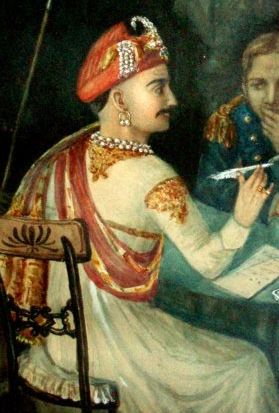Vishrambaug Wada on:
[Wikipedia]
[Google]
[Amazon]
Vishrambaag Wada ( mr, विश्रामबाग वाडा), a fine mansion situated at central Pune's Thorale Bajirao Road, was the luxurious residence of
 Vishrambaug Wada was built in 1807 AD at the price of Rs 200,000. It took six years to complete the construction. Baji Rao II preferred this residence to the ill-fated
Vishrambaug Wada was built in 1807 AD at the price of Rs 200,000. It took six years to complete the construction. Baji Rao II preferred this residence to the ill-fated
File:Peshwe Mahal in Vishrambaug Wada.jpg, Main Hall
File:Wooden carvings at Vishrambaug Wada--.jpg, Wooden Carvings
File:Vishrambaug Wada in Pune.jpg, Balcony
File:Laxmi 2.JPG, Front door
File:Inside view of Vishrambaug Wada's first floor.jpg, Inside View
File:Vishrambaug Wada Pune.JPG, Street view
File:Vishrambaug Wada View From Inside.jpg, Courtyard
File:Vishrambaug Wada Internals.jpg, Windows
Peshwa
The Peshwa (Pronunciation: e(ː)ʃʋaː was the appointed (later becoming hereditary) prime minister of the Maratha Empire of the Indian subcontinent. Originally, the Peshwas served as subordinates to the Chhatrapati (the Maratha king); later, ...
Baji Rao II
Shrimant Peshwa Baji Rao II (10 January 1775 – 28 January 1851) was the 13th and the last Peshwa of the Maratha Empire. He governed from 1795 to 1818. He was installed as a puppet ruler by the Maratha nobles, whose growing power prompted him ...
, the last Peshwa of Maratha confederacy
The Maratha Empire, also referred to as the Maratha Confederacy, was an early modern Indian confederation that came to dominate much of the Indian subcontinent in the 18th century. Maratha rule formally began in 1674 with the coronation of Shi ...
, in early 19th century
The 19th (nineteenth) century began on 1 January 1801 ( MDCCCI), and ended on 31 December 1900 ( MCM). The 19th century was the ninth century of the 2nd millennium.
The 19th century was characterized by vast social upheaval. Slavery was abolis ...
. The 20,000 sq.ft. wada presently houses a post office on its ground floor, a few other offices of the municipal corporation and a small museum of Maratha artifacts put together by noted Maratha historian, Babasaheb Purandare
Balwant Moreshwar Purandare (29 July 1922 – 15 November 2021), popularly known as Babasaheb Purandare, was an Indian historian and theatre personality from Maharashtra, India. He was awarded the Padma Vibhushan, India's highest second-civi ...
. This structure is famous for its fine entrance and the balcony with carved woodwork.
History
 Vishrambaug Wada was built in 1807 AD at the price of Rs 200,000. It took six years to complete the construction. Baji Rao II preferred this residence to the ill-fated
Vishrambaug Wada was built in 1807 AD at the price of Rs 200,000. It took six years to complete the construction. Baji Rao II preferred this residence to the ill-fated Shaniwar Wada
Shaniwar Wada is a historical fortification in the city of Pune, India.
Built in 1732, it was the great seat of the Peshwas of the Maratha Empire until 1818. Following the rise of the Maratha Empire, the palace became the center of Indian poli ...
, the citadel of the Peshwas. Baji Rao II stayed here for eleven years until his defeat in the Third Anglo-Maratha War
The Third Anglo-Maratha War (1817–1819) was the final and decisive conflict between the English East India Company and the Maratha Empire in India. The war left the Company in control of most of India. It began with an invasion of Maratha te ...
. After the war the British exiled him with a pension to Bithur
Bithoor or Bithur is a town in Kanpur District, by road north of the centre of Kanpur city, in Uttar Pradesh, India. Bithoor is situated on the right bank of the River Ganges, and is a centre of Hindu pilgrimage. . Bithoor is also the centre ...
near Kanpur
Kanpur or Cawnpore ( /kɑːnˈpʊər/ pronunciation (help·info)) is an industrial city in the central-western part of the state of Uttar Pradesh, India. Founded in 1207, Kanpur became one of the most important commercial and military stations o ...
. His wife, Varanasibai, continued to stay here for a while before joining him in Bithur. Soon the British took over Pune.
In 1821, the new East India Company
The East India Company (EIC) was an English, and later British, joint-stock company founded in 1600 and dissolved in 1874. It was formed to trade in the Indian Ocean region, initially with the East Indies (the Indian subcontinent and Southea ...
rulers of Pune started the Hindoo college in the Wada to continue Sanskrit learning in the city. The college was the forerunner of the Poona college which later became Deccan College. A high school called Vishrambag High School also operated out of the palace. In 1871, an act of arson entirely destroyed the eastern wing of the wada.
In 1930, the then Poona municipality bought the property from the colonial Bombay Presidency government for a sum of Rs 100,000. Until 1959, Municipality and its successor, the Pune Municipal Corporation
The Pune Municipal Corporation (PMC, IAST: Puṇe Mahānagarpālikā) is the civic body that governs the inner limits of Pune, India. It is in charge of the civic needs and infrastructure of the metropolis, which is spread over an area of 484 ...
(PMC) operated out of Vishrambaag Wada. Several PMC department offices were based in the wada until 2003.
Restoration
The PMC has undertaken the restoration work of Vishrambaag Wada under the ''Heritage Corridor Plan''. The conservation is set to be carried out in three phases, starting with the double storeyed mansion where the Peshwa is said to have lived with a battery of 6,000 servants. According to PMC’s heritage cell chief Shyam Dhavale, the original bricks wada, are specially being recreated. And so are some of the windows, wooden pillars and motifs. Red tiles on the sloping roof and the courtyard—a typical feature of Maratha architecture—will be retained. As of 2004, have been spent on the restoration work.Gallery
References